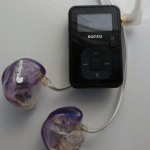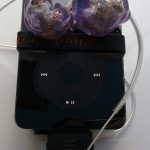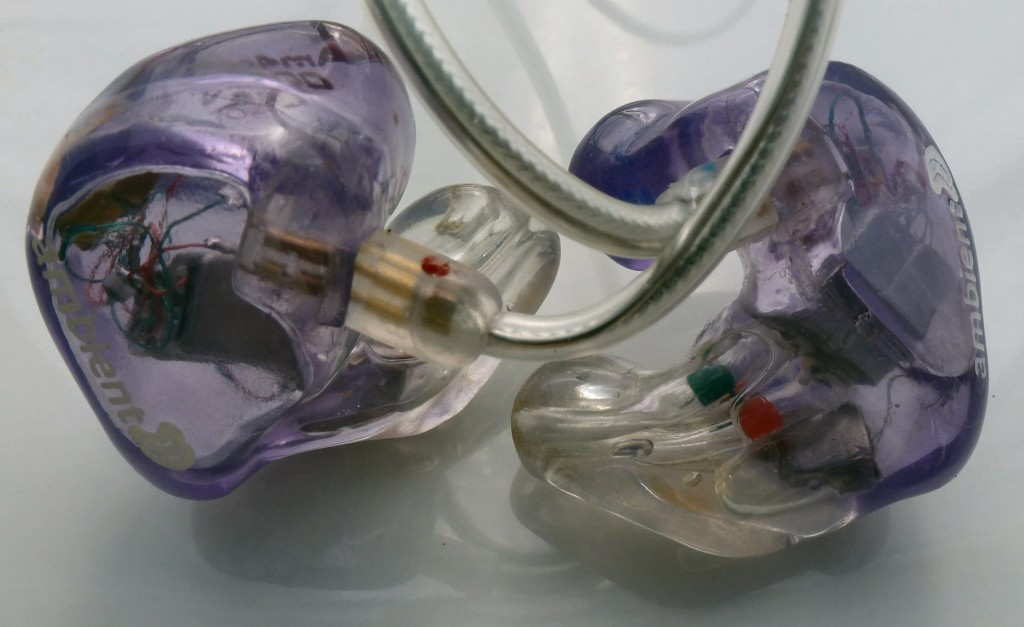Comparisons:
Alclair Reference Master: While there are distinct differences, these two both present with a balance from top to bottom, not overdoing any part of the spectrum. From a soundstage perspective, the AM4 pro presentation is more mid-forward with similar width, but the AM4 pro has a good deal more depth to the presentation, better clarity and slightly better resolution within the soundstage space. The Reference does have better instrument separation and more black space between instruments resulting in better imaging, but the left to right coherence results in a lack of a fill in the middle part of the soundstage. The AM4 pro advantages result in a more realistic and immersive experience. Instrument detail levels are close, but the AM4 pro edges out the Reference by a bit and also has better dynamics. Transparency is very similar between the two and the Reference is slightly more forgiving.
 Due to the more upfront presentation of the AM4 pro, the bass is a bit more up forward resulting in the perception of more bass emphasis when comparing the two, however in relation to the rest of the spectrum, the bass is similarly balanced. The bass, and especially the deep bass is more palpable with the AM4 pro, as the bass drivers have more ability to kick and rumble. Warmth is very similar. The vocals of the AM4 pro are more prominent, cleaner, and clearer. Even though the midrange is further back with the Reference, the upper midrange on up is close, which gives more emphasis to the Reference than the AM4 pro, if just by a bit. Since the AM4 pro has a better soundstage focus, the treble is cleaner, although pretty close in quantity. Note decay in the treble is close, but the AM4 pro does have a slightly longer note decay that sounds more natural.
Due to the more upfront presentation of the AM4 pro, the bass is a bit more up forward resulting in the perception of more bass emphasis when comparing the two, however in relation to the rest of the spectrum, the bass is similarly balanced. The bass, and especially the deep bass is more palpable with the AM4 pro, as the bass drivers have more ability to kick and rumble. Warmth is very similar. The vocals of the AM4 pro are more prominent, cleaner, and clearer. Even though the midrange is further back with the Reference, the upper midrange on up is close, which gives more emphasis to the Reference than the AM4 pro, if just by a bit. Since the AM4 pro has a better soundstage focus, the treble is cleaner, although pretty close in quantity. Note decay in the treble is close, but the AM4 pro does have a slightly longer note decay that sounds more natural.
With similar but different sound signatures, and considering the price, these two might be best being purchased from their respective regions: the Reference for people in the US and the AM4 pro for people in Europe. In a nutshell the Reference gives you a more laid back sound with a better overall presentation while the AM4 pro is more upfront with better instrument detail and dynamics resulting in better engagement within the presentation. The Reference represents someone in the audience listening to a presentation while with the AM4 pro you are involved in the performance.
Audio Earz Aud-5X: Tonal differences and presentation give these two different feels and sonic signatures, with the aud-5X having a more spacious presentation while the additional upper midrange of the AM4 pro give it a brighter feel. Both have spacious soundstages, but the AM4 pro has a good deal more depth to the presentation than the 5X. Even with a thicker note and smoother presentation, the 5X is slightly more detailed with more resolution of the overall presentation. Dynamics are fairly close, but the 5X pulls ahead while the AM4 pro is the easy winner in clarity and imaging. Speed is similar and transparency goes to the 5X. The AM4 pro is pretty forgiving, but the 5X is even more forgiving of poor tracks.
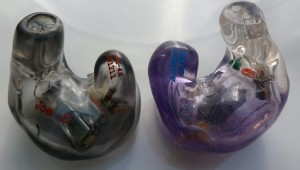 The three bass drivers of the 5X can really generate some rumble and impact, and while the AM4 pro isn’t bad in this region, bass heavy songs have noticeably more weight with the 5X, which also carries over to the mid-bass warmth and thickness. The midrange of the AM4 is more forward and engaging while in comparison the 5X midrange seems a bit recessed, yet still thicker and not providing quite the clarity. The upper midrange of the AM4 is in line with the midrange, but with the 5X it seems a bit more pronounced in comparison with the midrange. The treble of the AM4 is more pronounced while the 5X treble is a bit smoother, yet still retaining the detail.
The three bass drivers of the 5X can really generate some rumble and impact, and while the AM4 pro isn’t bad in this region, bass heavy songs have noticeably more weight with the 5X, which also carries over to the mid-bass warmth and thickness. The midrange of the AM4 is more forward and engaging while in comparison the 5X midrange seems a bit recessed, yet still thicker and not providing quite the clarity. The upper midrange of the AM4 is in line with the midrange, but with the 5X it seems a bit more pronounced in comparison with the midrange. The treble of the AM4 is more pronounced while the 5X treble is a bit smoother, yet still retaining the detail.
These two are very different in presentation, but not in capability. The AM4 is more forward, brighter presentation that has neutral bass and nice clarity while the 5X is quite capable in the bass region and will satisfy those looking for a smoother and thicker presentation across the spectrum. They complement each other well and both have exceptional performance considering the price.
Wan Xuan (Beat Audio) i9pro: The AM4 pro has a more intimate presentation compared with the more open, spacious, and laid back presentation, the i9pro. The soundstage is a good deal wider, but not quite as deep as the AM4 pro, resulting in a different feel. And the FST technology of the i9pro does add depth, but the depth is different than typical. Imaging and placement are better with the AM4 pro, giving a better focus of the overall presentation vs. the more spacious sounding i9pro. Instrument detail levels are about the same while the resolution of the presentation is better with the AM4 pro. They both have a natural note attack and decay, but the AM4 pro is quicker while the i9pro can sustain a note better. Dynamics and coherence favor the i9pro, but the AM4 pro is more clear and transparent.
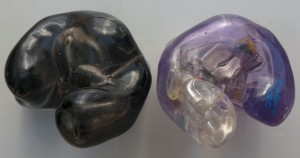 Bass of the i9pro is hits deeper, is more enhanced and more capable, giving a more powerful and bass skewed presentation. The i9pro is also warmer that leads up to a more relaxed midrange. The AM4 pro midrange is clearer and more concise as well as more intimate. The upper midrange and treble of the AM4 pro are more prominent, leading to a brighter sound and less variance of brightness between tracks. The i9pro did sound a bit dark in comparison with the AM4 pro in a few tracks.
Bass of the i9pro is hits deeper, is more enhanced and more capable, giving a more powerful and bass skewed presentation. The i9pro is also warmer that leads up to a more relaxed midrange. The AM4 pro midrange is clearer and more concise as well as more intimate. The upper midrange and treble of the AM4 pro are more prominent, leading to a brighter sound and less variance of brightness between tracks. The i9pro did sound a bit dark in comparison with the AM4 pro in a few tracks.
With two very different sound signatures, the AM4 pro and i9pro will hit different markets. The AM4 pro is for those that want a more reference sound and more intimate presentation, and brightness. The i9pro will satisfy bass heads and those that want a warm, lush, and non-offensive presentation.
Fabs Fabulous Earphones: The Fabs share a mid-forward presentation with the AM4 pro, but the Fabs aren’t quite as forward nor do they have the same technical ability. Overall there are quite a few differences, with the AM4 pro providing a full range presentation from top to bottom while the Fabs is more of a mid-focused presentation that doesn’t convey the entire presentation. The Fabs soundstage isn’t as wide or deep, the detail levels are less, there are less dynamics, imaging isn’t as good, and the focus within the soundstage falls short of the AM4 pro. The Fabs competes quite well with select tracks, but with the majority of my tracks display a large discrepancy. But it is not all bad for the Fabs as the clarity levels are close to the AM4 pro and coherence and transparence is actually a bit better. The AM4 pro is more forgiving of poor tracks even though it is brighter.
There are huge differences in bass levels as the Fabs are not a full shell and don’t insert deeply into my ears. The AM4 pro is more capable and fuller in the bass region while the Fabs become thicker in the midrange. Midranges are similar, but the Fabs is more liquid in the midrange but with lower detail levels, which is good for some tracks in comparison but not for most. Vocals are have a nice quality to them with the Fabs while the AM4 pro sounds more realistic and detailed. The Fabs treble slowly rolls off at a slow rate while the AM4 pro treble is more extended, but the Fabs has a thicker, smoother treble note which prevents cymbals from really shimmying. This gives the AM4 pro an air feel in comparison.
The Fabs will appeal to some, in part for the inline mic/remote capability, in part because of the music they listen to, which would be classical and easy listening/vocal type music, and in part due to the half shells. Paired with an iPhone, the differences are smaller than a high end source, but the AM4 pro still wins technically. Unless you have specific needs mentioned above or are treble averse, the AM4 pro is the better choice.
Minerva Mi-3: With a more distant and overall more spacious sound, the Mi-3 has a more laid back presentation that puts you in the audience. Given the difference in presentation location, both share forward mids, but both ends of the spectrum are quite different. The AM4 pro has a nice balance across the spectrum while the Mi-3 seems a bit rolled off on both ends. Technically the AM4 pro is superior in most ways including dynamics, detail, clarity, and speed while transparency and coherence are similar. Dynamics are a bit one, as the AM4 pro sounds more alive and punchy to go with more depth of the presentation and more refinement within the soundstage.
Both ends of the spectrum sound a bit lacking from the Mi-3 in comparison with the AM4 pro, and bass heavy tracks are significantly different, especially in rumble and impact. The thicker note of the Mi-3 and not as bright of a performance gives the Mi-3 a warmer presentation. The AM4 pro midrange is not only closer to you, but more detailed, cleaner, and clearer. The upper midrange and treble of the AM4 pro is a good deal more prominent, which is responsible for pulling the presentation forward. Overall the quality of both is very good with nice smoothness, but the Mi-3 is more liquid while the AM4 pro is more detailed and resolving.
The AM4 pro and Mi-3 have different feels, with the AM4 pro having a brighter, yet more bass capable sound that is more up front, especially in comparison with the laid back yet mid-forward Mi-3. Bass presentation is significantly different, as is the treble. The Mi-3 would make for a good casual listening CIEM if you don’t have bass heavy tracks while the AM4 pro is great for hearing more within the presentation and those that want a more upfront and involving presentation.
Thousand Sound TS842: These two are quite a bit different with the TS842 having more of a U shaped frequency response while the AM4 pro is more mid-forward. Even with a more mid-forward presentation, the AM4 pro has a bit wider soundstage and a good deal more depth to the presentation. The TS842 is analytical in the midrange on up and the dynamic bass driver is a quick and accurate driver, but still has a richer and thicker presentation while the AM4 pro is more consistent from top to bottom in note thickness. This give the AM4 pro a significant lead in coherence while dynamics and detail levels are slightly better with the TS842. With a more prominent midrange, better imaging, and a sharper focus within the soundstage, the AM4 pro has better clarity. The AM4 pro is a bit more transparent and slightly more forgiving of poor tracks.
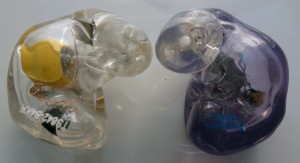 Bass is usually similar, but there are times when a song has deep, reverberant bass where the TS842 has an altogether different feel due to the dynamic bass driver. This feel conveys more power as well as better texturing, yet the bass of both is quite neutral. Overall the TS842 does have a bit more bass and warmth. The midranges are very different as the AM4 pro has a bit of a forward midrange while the TS842 has a laid back midrange. This results in a more engaging presentation from the AM4 pro and the better imaging, presentation depth, and focus make for a more involving midrange. The upper midrange of both is different in that the AM4 pro upper mids are an extension of the midrange while the TS842 has a ramp up, making that section brighter with the AM4 pro. However, once you get into the treble region, the TS842 is brighter in relation to the midrange. Both have an analytical edge to the treble, but the TS842 more so.
Bass is usually similar, but there are times when a song has deep, reverberant bass where the TS842 has an altogether different feel due to the dynamic bass driver. This feel conveys more power as well as better texturing, yet the bass of both is quite neutral. Overall the TS842 does have a bit more bass and warmth. The midranges are very different as the AM4 pro has a bit of a forward midrange while the TS842 has a laid back midrange. This results in a more engaging presentation from the AM4 pro and the better imaging, presentation depth, and focus make for a more involving midrange. The upper midrange of both is different in that the AM4 pro upper mids are an extension of the midrange while the TS842 has a ramp up, making that section brighter with the AM4 pro. However, once you get into the treble region, the TS842 is brighter in relation to the midrange. Both have an analytical edge to the treble, but the TS842 more so.
Choosing between the two should be easy…do you want an up-front presentation or a laid back one? All else is minor differences on top of those major differences. Things such as the bass power of the TS842’s dynamic driver, or the involving midrange of the AM4 pro. But, both stopped me from reviewing to just listen.
Dunu DC4: The upper midrange and treble presentation take these two in different directions as the AM4 pro is brighter in comparison with the slightly bass enhanced and warmer DC4. Both present very similarly other than the warmth and brightness differences, however the AM4 pro is a good deal clearer due to the added brightness. Size wise, the AM4 pro has better depth and width which gives the DC4 a more personal presentation, however imaging is close. Detail levels and resolution within the soundstage are close, with the DC4 pulling slightly ahead of the AM4 pro in both. Combining the presentation and clarity with a slightly better focus, the AM4 pro sounds clearer and makes the DC4 sound slightly veiled in comparison. The DC4 also has better dynamics, coherence across the frequency spectrum, and transparency, but note attack and decay has more range with the AM4 pro resulting in a more realistic note and a bit more speed for fast music. The DC4 is more forgiving of poorly mastered tracks.
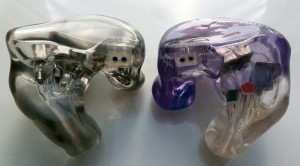 While the DC4 has more bass, both in enhancement and in capability to output rumble, the AM4 pro isn’t too far behind and has a much tighter low end that has better texturing. The DC4 is warmer and thicker throughout the entire presentation. While the midrange is presented similarly, the larger soundstage of the AM4 pro gives a more open and spacious feel in comparison with the intimate and somewhat veiled DC4. The upper midrange on up through the treble of the AM4 pro is more pronounced resulting in a brighter and clearer sound. Quality is good with both, but the AM4 pro sounds more realistic.
While the DC4 has more bass, both in enhancement and in capability to output rumble, the AM4 pro isn’t too far behind and has a much tighter low end that has better texturing. The DC4 is warmer and thicker throughout the entire presentation. While the midrange is presented similarly, the larger soundstage of the AM4 pro gives a more open and spacious feel in comparison with the intimate and somewhat veiled DC4. The upper midrange on up through the treble of the AM4 pro is more pronounced resulting in a brighter and clearer sound. Quality is good with both, but the AM4 pro sounds more realistic.
Both share their presentation style, but offer different flavors, with the AM4 pro having a brighter presentation wrapped in a larger overall soundstage that is more neutral while the DC4 is more intimate with more bass emphasis and warmth. Neither makes the other sound bad, and it comes down to what you are looking for and availability. Technically they are close, but the AM4 pro edges out the DC4.
ACS T1 Live!: The AM4 pro puts you closer to the performance with a more mid-forward presentation, but the spaciousness combined with the forwardness of the presentation grabs you more than the T1. Tonality is quite close between these two. The T1 Live! has a bit wider presentation but the AM4 pro has better depth of presentation. The T1 Live! bests the AM4 pro in clarity within the soundstage, although both suffer from reduction in clarity within the soundstage at louder volumes. Dynamics of the T1 Live! are a better in the mids and treble while the bass dynamics of the AM4 pro are superior. The AM4 pro has a bit more speed to the presentation and is more forgiving however the T1 Live! is more transparent and coherent.
 The AM4 pro bas more kick down low with better extension and more weight for bass heavy songs. The quality of the bass is a bit better with the T1 Live!, but given the AM4 pro can output more bass, that is a limiting factor for the T1 Live!. Warmth is quite similar. The midranges are where the two diverge the most as the T1 Live! is more laid back and gives a more airy, wide presentation while the AM4 pro is more up-front and personal with exceptional depth of presentation. Resolution and detail levels are a bit better with the T1 Live! There is a bit more treble presence with the T1 Live! while the AM4 pro treble sounds more natural and of higher quality.
The AM4 pro bas more kick down low with better extension and more weight for bass heavy songs. The quality of the bass is a bit better with the T1 Live!, but given the AM4 pro can output more bass, that is a limiting factor for the T1 Live!. Warmth is quite similar. The midranges are where the two diverge the most as the T1 Live! is more laid back and gives a more airy, wide presentation while the AM4 pro is more up-front and personal with exceptional depth of presentation. Resolution and detail levels are a bit better with the T1 Live! There is a bit more treble presence with the T1 Live! while the AM4 pro treble sounds more natural and of higher quality.
Essentially, the AM4 pro is a more mid-forward, slightly less bright, and more bass capable version of the T1 Live!. Now, it isn’t as simple as that, but the comparison is there. Of course, the T1 Live! is easier to get, easier to service, uses silicone, and has mics for ambient feedback, but from a pure sound perspective, the price difference and not too large sound differences should make you think.
Logitech Ultimate Ears In-Ear Reference Monitor: Both are reference monitors, so I decided to compare the two despite the price difference. The overall presentation of the IERM is larger and makes the AM4 pro sound mid-forward in comparison. Detail levels and attack/decay capability are close, with the IERM slightly edges out the AM4 pro in both. Transparency is better with the IERM, but the AM4 pro is more coherent. Dynamics are similar, except in the bass where the AM4 pro pulls ahead of the IERM. Imaging and soundstage space are superior on the IERM even though the AM4 pro has excellent soundstage depth, the overall size doesn’t quite compare. Clarity, while very good with the AM4 pro is bested by the IERM.
 The AM4 pro outputs a larger quantity of bass that extends deeper conveying more power with better bass detail and has slightly better texturing. While not necessarily warm, the AM4 pro is warmer than the IERM. With a more mid-forward presentation, the AM4 pro’s places vocals closer while giving them a more clear and concise presentation, but with a bit more upper midrange and treble presence, the IERM is overall clearer with a greater sense of air, however with anything but the best mastering, the IERM is much harsher than the AM4 pro to my ears.
The AM4 pro outputs a larger quantity of bass that extends deeper conveying more power with better bass detail and has slightly better texturing. While not necessarily warm, the AM4 pro is warmer than the IERM. With a more mid-forward presentation, the AM4 pro’s places vocals closer while giving them a more clear and concise presentation, but with a bit more upper midrange and treble presence, the IERM is overall clearer with a greater sense of air, however with anything but the best mastering, the IERM is much harsher than the AM4 pro to my ears.
Fans of bright and spacious will prefer the IERM vs. the more mid-forward and balanced AM4 pro. The IERM does outperform the AM4 pro from a technical ability standpoint, but the AM4 pro offers a presentation that combines a musical performance with analytical flair. Those that want more bass will prefer the AM4 pro even though both are fairly neutral. The IERM has more of a monitoring sound while the AM4 pro would be better on stage.
Vsonic GR07: This comparison isn’t focusing on the higher levels of detail, better clarity and dynamics, etc., but instead on the sound signature differences. The upper bass of the GR07 is more prominent while the deep bass rumble and performance is similar. The midrange of the GR07 is more laid back while the AM4 pro has more prominent upper mids and an overall brighter presentation. The presentation space of the AM4 is larger in both width and depth. Due to the higher resolution/detail levels, the AM4 pro is more revealing of both details within the presentation and poor sound quality of bad tracks. Essentially, the AM4 pro is brighter and more mid-forward while offering more detail, space, dynamics and clarity with similar bass reproduction.
Source matching
Portable Sources, DAPs
Clip+: The Clip+ offers decent sound one would expect when combining the Clip+ with the AM4 pro, good but not great sound. Dynamics aren’t what they are with an amp or a better source, and the overall soundstage is a bit small and doesn’t have great depth. Deep bass is surprisingly not as powerful as with the iPhone 4S, or even the RoCoo BA. 3/10
iPhone 4S: With a brighter and more spacious presentation than the Clip+, the iPhone has many advantages, which also include better bass power resulting in more emphasis and rumble. The overall space is larger and the depth of presentation is also better. Detail levels aren’t quite as high as the Clip+, nor are dynamics in the midrange. Overall a good presentation considering the convenience factor. 4/10
RoCoo BA: Adding a slightly more spacious sound and better dynamics than either the iPhone 4S or Clip+, the BA presents with a bit more forward midrange and a more refined, smoother presentation. Detail levels are higher, but not to the level of the 801 or DX100. Not bad, but not the best. 5.5/10
801 (with GAME card): The 801 opens up the AM4 pro and allows it to show what it is capable of, taking the performance up a notch. Bass is more authoritative, depth of the presentation as well as the overall space improve significantly, and detail levels increase. The combo isn’t overly bright and does sound like the treble is laid back in comparison with other sources, which sounds fine with some tracks and not the greatest with others. The treble of the 801 with the AM4 pro can be rough and less than the smooth and musical presentation of other sources including the RoCoo BA (although it bests the BA in many ways) and the iPod-> 627. While the 801 doesn’t bring the AM4 pro to the level of CIEMs that cost double, it does close the gap. 7/10
DX100: The DX100 takes what the 801 does and improves upon it. Depth of the presentation is better and the sound is more natural, smooth, and flowing resulting in an incredibly involving presentation. While the 801 can be harsh with poorly mastered tracks (some of my pop and metal favorites), the DX100 isn’t nearly as offensive. Overall, the sound isn’t quite as spacious as the 801->627, but the differences are minimal and for one unit, it is quite good. 9.5/10
Portable Sources, DAPs with Amps
iPhone 4S ->
i.Fuzen amp case: The i.Fuzen is not as bright as the HPO, and therefore gives a more bass heavy presentation. The i.Fuzen ever so slightly improved the overall sound quality, but I mean slightly, however the darker, more bass heavy sound changes the character of the AM4 pro quite a bit. This can be good or bad depending on what you want from the AM4 pro. 4/10
Pico Slim: The PS adds a bit of brightness over the HPO, but also adds presentation depth, but has a slightly smaller presentation. The overall presentation is cleaned up a bit by the PS, adding a bit to clarity. With a smoother presentation and more resolution, the PS is more musical and transparent than the HPO. 5/10
627: The 627 opens up the presentation, making it more airy, laid back, and spacious with better depth of the presentation. The resolution is improved and the entire presentation sounds more realistic as details are easier to make out within the layered presentation, bass is more controlled and authoritative, and the tonality sounds quite right. 6/10
Modded iPod -> Overall the modded iPod doesn’t convey the spatial information the AM4 pro is capable of from the 801 and DX100, and the RoCoo BA also has a bit more depth.
Neco V2: Decent spaciousness and control of the presentation, but after listening to the DX100 for an extended period of time, the V2 doesn’t have the spaciousness, control, or clarity, and the presentation is more analytical, yet less detailed. But, considering this setup cost less, a good deal less, it is better than the similar setup from an iPhone. 5/10
Shonyun-306: The 306 is a bit more forward and smaller in presentation width than the V2 with less bass impact and control, but has a bit more depth to the presentation and is slightly brighter. Treble isn’t quite as smooth as the V2. 4.5/10
EPH-O2: The O2 is a much better match with the AM4 pro than the V2 and 306, with a smoother and more refined top end, wider presentation that is a bit more laid back with better depth. The is better refinement within the larger presentation space also consists of having more reverb with string instrument resulting in a more natural sound. This setup is more spacious than the RoCoo D, although the RoCoo has more depth in proportion to the soundstage width and has a nice air and smoothness to it. There is a channel imbalance, so I had to turn the line out volume of the iPod down to eliminate it (-1 point to the score). 5/10
uHA-120: The O2 is slightly more spacious than the uHA-120, and the treble is a bit more laid back and smoother, although the uHA has a bit better depth to the presentation along with a slight bit better clarity within the soundstage. Bass is tighter and punchier with the uHA, with less quantity, especially in the mid-bass. There is a channel imbalance at low volumes (-0.5 points to the score) 6/10
Arrow 12HE 4G: With a more laid back and spacious presentation, the treble is relaxed and there is more emphasis on the mid-bass compared with the uHA-120. Overall the uHA is a bit cleaner than the 4G with more depth to the presentation space and deep bass more prominent. There is a severe channel imbalance at very low volume levels (-0.5 to the score) 5.5/10
Pico Slim: The Pico Slim adds a fullness to the presentation giving it a richer presentation in addition to brightening the sound in a clean way. The presentation of space is better overall than all the amps listed above with both depth and width. Resolution within the presentation isn’t the highest, but what is there is very clean and well controlled. And speaking of control, the PS has better control than the 4G and uHA. 6.5/10
Stepdance: The SD has a nice balance across the spectrum and doesn’t do anything wrong, but the PS does best it in depth of presentation while keeping up with it in everything else, but surprisingly the PS has a bit more deep bass punch and slightly more control. Clarity of the presentation is about the same. The SD is not quite as bright as the PS, but it isn’t too far off. 6/10
Cruise: While the cruise has a very dynamic presentation that really adds excitement to the AM4 pro, there are issues. The amp is more spacious than the PS or SD by a bit, a little cleaner, but there is hiss and a very minor very low volume channel imbalance that keep the Cruise from being a strong recommendation for the AM4 pro. Other than those two things, the amp performs quite well, although it does brighten the presentation. (-1 due to hiss) 5/5/10
627: The 627 is more spacious and fuller than the PS, which is the 2nd best performing amp in I have. The entire presentation is cleaner and smoother, which is most noticeable in the treble. The 627 has better layering than the PS, but the real thing holding it back in this combination is the iPod. There is an ever so slight channel imbalance at very low volumes. 7/10
801 ->
Pico Slim: The PS brightens the presentation giving it a sound that is closer to other sources. The overall presentation is better than the HPO as it is a bit smoother and more forgiving, but not all that much. The overall presentation is a bit more mid-forward and slightly smaller. 7.5/10
627: The 627 simply takes what the 801 does and improves on it in every way, including brightening the presentation up. Bass is tighter yet more prominent when the track calls for it, space is greater and the overall sound is more airy, more detail comes through, and the overall sound is more refined, involving, and engaging. 9/10
Desktop Sources
HUD-MX1 (OPA1611): Due to the high sensitivity of the AM4 pro, my MX1 has a channel imbalance at low to moderate volumes. Unfortunately this takes away from what is a decent pairing as the MX1 is quite neutral and detailed with decent depth. Bass is well controlled and the treble is smooth and pleasant yet still detailed. Space is on par with the more expensive Cruise, although dynamics aren’t at the same level. (-1 for imbalance) 5/10.
Cruise: As with the pairing with the iPod, the Cruise sound punchy and nice except for the hiss and slight channel imbalance. The details and speed of the DAC + amp lead to a less forgiving treble, which takes away from the presentation. I could recommend this combo as the sound isn’t that bad, but the hiss is disappointing. (-1 for hiss) 5.5/10
D1: While the DX100 and 801 sound exceptional with the AM4 pro, the D1 is more spacious, specifically in the depth of presentation. Bass is powerful and well controlled resulting in an amazing sound for the price of the AM4 pro. Compared with the 801 -> 627, the D1 isn’t too far behind in soundstage size and overall resolution, but does have slightly less layering. 10/10
Source Summary: The AM4 pro is very scalable: feed it from a better source chain and you will get better results. The difference between the highest and lowest performing sources is quite large and the AM4 pro is selective about the amps/sources it pairs well with. Sensitive being on the high side brings out low volume balance issues for many amps. If you feed it from an average source, the performance will be in line with the price, but pairing it with a higher end source, the AM4 pro can punch above its weight. A better source can, depending on the synergy, help tame the clarity within the soundstage and the treble smoothness, both of which are weaknesses of the AM4 pro with lower end sources.
Summary
The Ambient Acoustics AM4 pro is an exceptional performer at the price point with a relatively neutral and very natural sound that works for the stage, studio, or just enjoying music. Note decay is very realistic, the soundstage is very 3D with exceptional depth, and dynamic range is impressive, all resulting in a presentation that immersive and engaging while staying neutral but still musical. When supplied by a high quality amp, the AM4 pro can compete with CIEMs that cost double as it scales very well. However, with lower end sources and at louder volumes the clarity can suffer as complex material becomes slightly congested. Overall the AM4 pro performs admirably and will surely develop a following due to the sound quality and value.
Pros
– Very capable in the bass region with great dynamics throughout the frequency spectrum
– Exceptional depth of the presentation for the price range
– Note decay is very natural from top to bottom with a blend of detail and liquidity resulting in an extremely musical, involving, and believable presentation
Cons
– At louder than medium volume the clarity and quality of the presentation decrease
– The AM4 pro is sensitive to the quality of the source components, and treble refinement suffers with lower end sources

